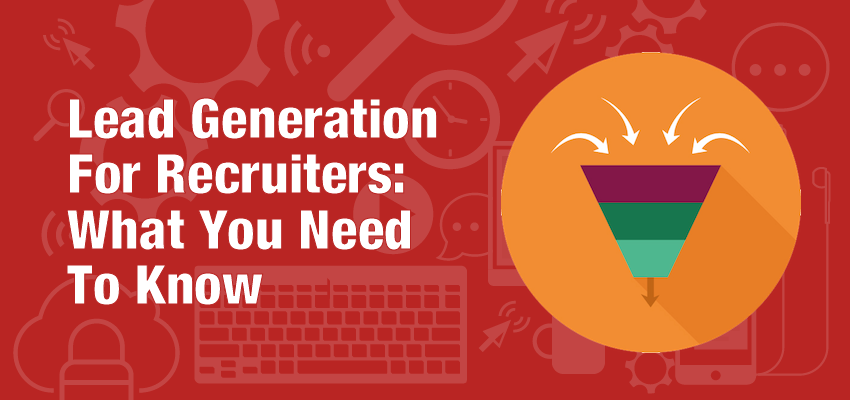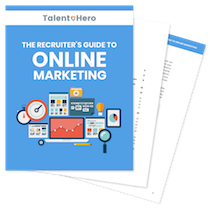Traditionally, lead generation for recruiters has been straightforward.
If you wanted to build a client base, you picked up the phone and cold called. The person who could make the most calls with the best script won.
But as the world has changed, the effectiveness of this lead generation method has slowly declined.
Everyone screens their calls. People prefer communication over email and text. Getting someone to return a voicemail is almost impossible.
And while there is obviously still a place for cold calling, recruitment agencies today also need new lead generation ideas to boost their outreach and engage with new prospects.
That’s where online lead generation for recruiters enters the picture.
Online recruiting lead generation opportunities are plentiful but confusing. That’s why I want to break them down so you can figure out what’s best for your recruitment agency.
In this article, we’ll walk you through the various lead generating tools for recruitment firms (paid advertising, SEO, social and email marketing) and discuss their pros and cons.
Table of Contents
How to develop a lead generation strategy
Before we get into the top lead generation tools for recruiters, let’s zoom out for a moment and think about the big picture.
All of the methods I’ll talk about in this article can generate new, high-quality leads – but, on the flip side, they could all end up being a waste of time and money if done poorly.
What makes this question more complicated: not every tool is going to work equally well for everyone. The industry you recruit for, the size of your business, and the types of companies or candidates you want to attract are all going to play a part in which lead generation strategies are most productive.
Taking a strategic approach to lead generation helps you choose the right tools for your business, first and foremost. It also shapes how you use those techniques and helps you ensure you’re tracking the right kinds of metrics to gauge their success.
Developing a lead generation strategy doesn’t need to be a long and complicated process. It really comes down to thinking critically about your business and your goals for it. To do that, you can follow a few basic steps:
- Define your target audience. Get as specific as you can with details like the niche, company size, region, and pain points for your ideal lead. One challenging thing about lead generation for recruiters is that you’re often marketing to two distinct groups: companies hiring in your niche and candidates who can fill those roles. This may mean defining multiple target audiences for different campaigns.
- Define your goals. This can start with your business objectives and how generating leads will contribute to them. From there, you can clarify the specific objectives of this campaign, whether it’s to grow revenue, enhance brand awareness, or expand your reach into a new market or segment.
- Set your budget. How much you’re willing and able to spend will directly influence which lead generation techniques are the best fit, as well as whether you’ll hire an agency or implement the campaign in-house.
- Assess your strengths and resources. Where aligning campaigns to your objectives ensures you’re targeting the right outcomes, aligning with your capabilities improves your odds of achieving them. Identify what you already do well and capitalize on that expertise to get the best results for the least effort.
- Choose your tools and channels. Once you know your audience, goals, budget, and strengths, the tools and channels best aligned with them will often be obvious. If not, prioritize them based on which will be the most likely to reach the types of leads you want to attract.
- Test and track your content. Even a well-designed campaign will need to be refined and improved over time. Use strategies like A/B testing or multivariate testing to gauge how different campaign elements, lead magnets, or other factors influence engagement, and track performance over time to identify trends or patterns.
- Analyze and refine. Regularly review the key metrics from past campaigns and build on those insights when designing your next one to make steady improvements over time. Remember that lead quantity isn’t the only factor to consider. Improving the quality of leads can also drive more conversions and sales, as can making improvements to how you nurture leads you’ve pulled into your funnel.
Paid Advertising
Google Ads
The allure of Google Ads for sourcing recruitment leads is obvious.
By only displaying ads when people’s searches match a list of keywords that you provided to Google, you should be targeting only people with a high buying intent – the people who are directly interested in hiring a recruiter.
However, the devil is in the details.
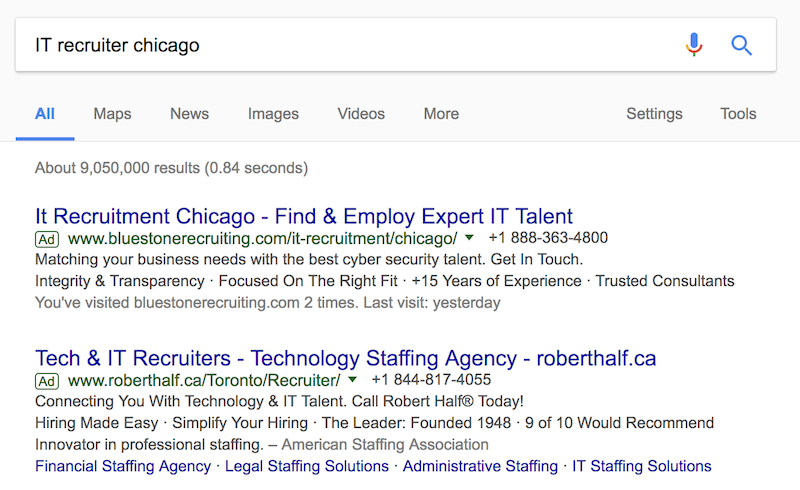
Google Ads is not only the quickest way to find client leads but also the fastest way to blow a massive hole in your marketing budget.
The Google Ads space in recruiting can be competitive, driving up the cost-per-click (CPC) to $10 or even $15.
And Google Ads is often a lot more complex than it appears. In order to run profitable campaigns that succeed in generating leads for your staffing agency, you need to have a highly optimized set of keywords, ads and landing pages.
While Google encourages people to dive right in and set up a campaign on their own, I would recommend leaving this lead generation tool to the professionals.
Pros
- Unlike every other ad platform, Google Ads can target ads towards people based on their needs at the exact moment of their search. This ensures that you only display ads to people that have a high buying intent.
- Ads can be customized to match a person’s exact search, increasing the odds that the ad is clicked. For example, if someone searches for “Chicago IT recruiter”, you can swap their search query into an ad headline so that the ad reads something like “Chicago IT recruiter – Your recruiting specialists”.
Cons
- If you are not careful, Google’s default settings will cause you to blow through hundreds or thousands of dollars before you figure out what you’re doing wrong.
- In some regions and industries, the CPC can be high, making it difficult to run a profitable campaign.
Not interested in doing your own lead generation?
Talent Hero can do it for you
Social Media Advertising
Social media advertising is quite popular these days and for good reason. The ability to target your audience directly in their feed based on precise demographic criteria is a handy tool in the advertiser’s arsenal.
These platforms also have built-in analytics for advertisers that can give you useful information about who is viewing and engaging with your ads, as well as automation tools that can save you time and money.
While each platform offers slightly different targeting preferences based on the demographic data they have available, LinkedIn is the obvious choice for recruiters trying to find new clients or candidates.
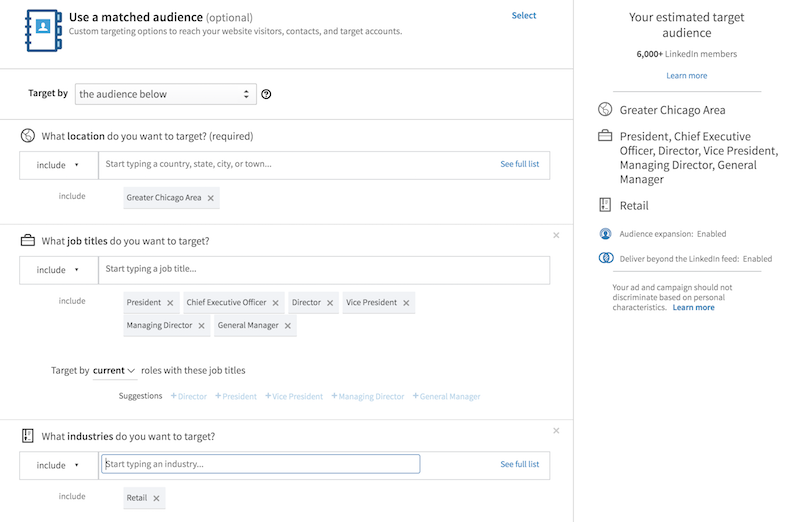
In the example above, we can see how a Chicago-based recruiter specializing in executive search for the retail industry can quickly find 6000+ LinkedIn members to target with an ad that is personalized to them.
However, much like AdWords, social media advertising for recruitment lead generation has its challenges.
Demographic-based targeting can make it difficult to get in front of a potential new client or candidate at the exact moment when they actually care about the recruiting service you’re offering.
Even if the right people see your ads, that won’t help you if it gets little to no engagement.
It’s therefore important to create an ad campaign that is so compelling that someone is willing to click it even when they’re not in the precisely right spot in your buying cycle.
Easier said than done…
Pros
- Demographic targeting allows you to hone in on your specific audience with relative ease. To make things even better, retargeting is helpful for nurturing leads, ensuring that you get the people who expressed some interest in your brand to come back to your site.
- Facebook’s demographic data is far richer than other platforms and if you get creative, you can target people at a more granular level than you might even imagine.
Cons
- Even if you know that a person is in charge of hiring decisions at the exact type of company you’re targeting, it’s not always easy to get an ad in front of them at the precise moment they are hiring.
- It can be difficult to spend $25-$100 per day on an ad campaign if you have a limited budget, especially when you cannot be certain exactly how long it will take to refine the campaign and see enough conversion to make it profitable.
Banner Ads
Banner ads have been around since the beginning of the Internet and for good reason.
When used judiciously, they can be a highly effective means of targeting the decision-makers at firms for which you want to recruit.
However, much like other forms of paid advertising, they have their drawbacks.
Banners ads are so prevalent that many people have developed ad blindness, a term referring to the state where people ignore ads prior to even focusing their attention on them.
Also, it is not always as easy to target people demographically with banner ads.
It’s therefore critical that you perfect your branding and think long and hard about your targeting strategy before you start paying for banner ads as part of a recruitment lead generation strategy.
Pros
- Banner ads can be a cheap and quick way to experiment with the paid ad game.
- You can target people and companies in a specific industry by placing ads in industry-specific magazines. For example, a healthcare recruiter that wants to get in touch with decision-makers could advertise in publications such as Healthcare Informatics or HealthData Management.
Cons
- If you advertise in a display network such the Google Display Network, you need to be very careful with your targeting criteria or you will end up showing ads to irrelevant audiences.
- Ad blockers such as AdBlock are so prevalent that some people will never see your ads, regardless of the ad platform you use.
Search Engine Optimization (SEO)
SEO is the practice of optimizing your website so that you rank highly for search queries relevant to your business. When done correctly, this can be a powerful, low-effort inbound lead generator.
If you can achieve your objectives with this lead generation tactic, you are pretty much set as you watch Google funnel free traffic to your site (and free leads into your pipeline) on a daily basis.
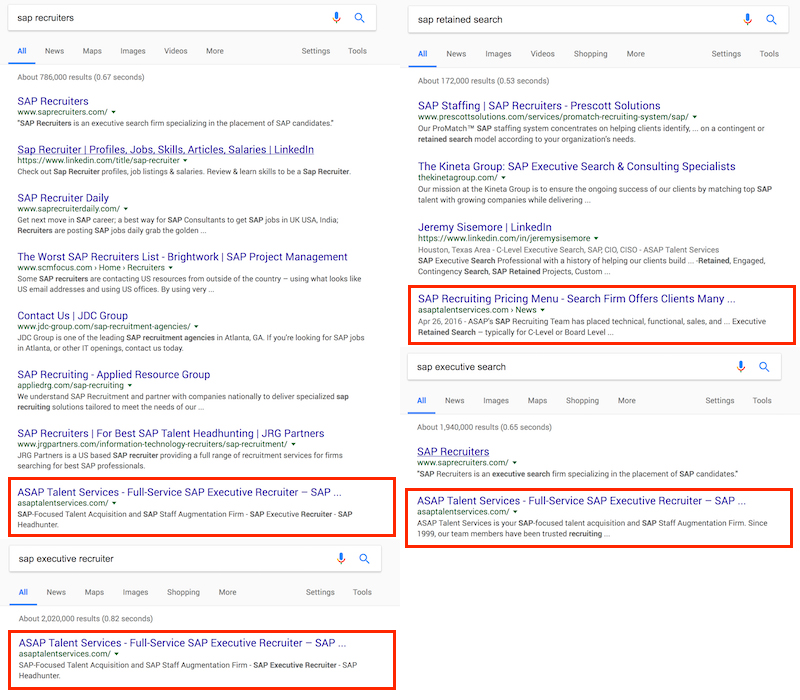
Guess who gets a lot of search traffic in the SAP recruiting market?
So what’s the catch?
To get your site to rank for important keywords, there is typically a large upfront commitment in time, money or both.
But if you’re ready, you need to think about two components of SEO: on-page and off-page.
On-page SEO
On-page SEO is the process of optimizing the site structure and individual pages of your recruiter site to maximize search traffic.
The great part about on-page SEO is that it is typically a task you can do entirely on your own as part of a self-directed recruitment lead generation strategy.
Backlinko’s on-page SEO guide is a great resource to review when you are first getting started.
Off-page SEO
Off-page SEO is essentially another name for link building – getting other sites to link to your site.
While it is nice when sites give you a natural link because you have such good content, you will find that it is much more likely that people will link to you if you engage in deliberate link-building activities.
These can include guest posting on other sites and asking influencers to share your content.
Networking and building connections with thought leaders in your target industries can also be beneficial here. Once you have those relationships, you can arrange mutual backlinks or reciprocal content sharing agreements, potentially giving both of you a boost in visibility.
Pros
- Once you start to rank for organic keywords, you can get a significant amount of traffic to your site without any additional cost.
- When a potential client finds you via search, you gain the recruitment seat of power, a position that you want to achieve in every negotiation.
- If you have a WordPress site, the Yoast SEO plugin provides a handy on-page SEO checklist for every page and post on your site.
Cons
- Optimizing your site for on-page SEO can take a lot of time, especially if you have a large number of old blog posts that you wrote without a clear search traffic intent in mind.
- Getting people to link to your site is costly, either in time or money.
- If you want to write guest posts for other sites that link back to you, you will need to come up with many blog posts ideas and then either write the posts yourself or pay someone to do it.
- If you want to generate content that is so good that a large number of other sites will link directly to it, you can expect to spend at least 50 hours or $1000 per piece of content. For example, our Tools For Recruiters post, which has received a large number of links, took about 70 hours to complete.
Social Media
The promises of social media marketers who say that you can build your business without spending a dime are lofty but as with all marketing channels, the reality is a bit murkier.
Social media marketing is the process of publishing content on LinkedIn, Facebook and Twitter to reach your target audience.
The challenges of turning social media into a legitimate lead generation tool are significant.
They include a declining organic reach, the difficulty of finding an audience that cares about what you’re posting and the time-consuming nature of sharing content.
We’ve already talked about how you can save yourself some time by automating the sharing process but there is not much you can do about the organic reach problem. As social media platforms continue to grow, they are increasingly showing business-related content on behalf of their paying advertisers only.
Pros
- If you can figure out how to build a large following, you have a free source of traffic on your hands.
- LinkedIn is a natural social media platform for recruiters so it makes sense to spend some time on the site regardless of your primary marketing approach.
Cons
- Publishing content to the 1000 people who have liked your page on Facebook but knowing that it will only be seen by 50 of them can be discouraging – and the problem is only likely to get worse as organic reach continues to decline.
- Many people don’t like to mix work and leisure and won’t read content that relates to their job while they are browsing social media for pleasure.
Email Marketing
Email marketing as an outbound recruitment lead generation tactic can be a goldmine for businesses that have a large email list. In fact, email is the only free lead generation option that is guaranteed to get your message in front of your audience.
When thinking about email marketing, you must remember one fact: people delete most of the emails they subscribe to without opening them so you’d better have an eye-catching subject and engaging content if you expect your subscribers to get excited when they see your email in their inbox. (We wrote about how you can do that in a previous post).
Pros
- It’s rare to find something in life that is free and valuable but when done right, email marketing falls into that category.
- Once you hit upon an email marketing concept that works, you can often spend as little as an hour per week setting up your newsletter.
Cons
- If you have a large database of contacts, free email marketing is a bit more tricky. There are options like Sendy which are essentially free but more user-friendly tools tend to cost money.
- Most people want to save time and so they send out a single email to their entire list. Unfortunately, this is a terrible idea. While segmenting your list and sending out more personalized content is the way to go, it’s often quite time-consuming to set up and execute.
How to track and optimize your lead generation efforts
You don’t just want to throw an ad campaign online and hope for the best. Tracking the results of your efforts lets you pinpoint what works, what doesn’t, and how you can get an even better return on your investment on the next go round.
The first question you need to answer is what kinds of metrics will be the best to track. This will vary depending on both your goals and the tool or technique you’re using.
Some of the key metrics that are often good indicators of a lead generation campaign’s effectiveness include things like:
- Website traffic – How many visitors are coming to your site. An increase in traffic indicates your campaigns are working to attract new potential customers, though you’ll need to look at other figures to see whether you’re capturing them effectively.
- Bounce rate – The percent of visitors who leave your site after viewing just the first page. A high bounce rate often means you need better targeting or a better user experience on the site – you’re drawing traffic to the site, but those visitors aren’t interested in what they find there.
- Conversion rate – The percent of qualified leads that are converted into customers. This is one of the most consistently useful metrics. A low conversion rate is often a red flag that you’re not reaching the right audience.
- Cost of customer acquisition (CAC) – How much you spend to generate each lead, determined by dividing the total spent on the campaign by the number of new customers it brought in. While the goal is always for this to be as low as possible, the best target cost to shoot for will depend on the type of campaign you’re conducting.
- Cost per lead (CPL) – Most useful for paid ad campaigns, you can find this by dividing the total spend by the number of new leads. Comparing CPL between channels or campaigns can indicate which is your best source of leads, useful information for refining where you devote your budget in the future.
- Lead value – This is determined by dividing your revenue from incoming sales by the total leads your campaign generated. It’s an excellent metric to assess the quality of your leads and how much new revenue your efforts are bringing in.
- Engagement – This is a metric specific to social media, and is typically a measure that combines likes, comments, and shares that a post garners. Low engagement indicates either that your posts aren’t interesting to your audience, or that you’re not getting them in front of the right people.
- Click-through rate – For email marketing campaigns, the click-through rate tells you how many recipients clicked on links in the message. This is often more useful than stats like open rates, telling you not just whether your campaign caught someone’s interest, but whether it made them want to take action and learn more.
Along with these campaign-specific metrics, you should also pay attention to big-picture figures like your monthly recurring revenue, average revenue per customer, and sales qualified opportunities (SQOs). Tracking changes in these figures gives you a sense of how all your marketing efforts are coming together to grow your presence in your market.
Often, lead generation tools will have built-in analytics that make finding these key metrics easy. Most email marketing platforms will list stats right on your dashboard, for instance, and the same is true of paid ad platforms like Google Ads or social media ads.
You can also use stand-alone analytics tools to get this data. Google Analytics is the go-to for measuring web traffic. For tracking customer behavior, it’s helpful to use a CRM like HubSpot or Zoho, which you can often integrate with tools like Google Analytics to get an overview of your whole customer journey.
Refer back to your campaign goals when you’re choosing which metrics to track. If your goal is to grow your brand presence, then metrics like website traffic and engagement will be good indicators.
Those may not be the best success indicators if your goal is to drive revenue growth, though – in that case, metrics like conversion rate and lead value will be more useful.
A few last tips for optimizing your recruitment lead generation:
- When you’re first starting, try a few different platforms and content formats to get a sense for how your audience responds to different strategies. As you refine your approach, you can get more granular with this testing – for example, once you’ve decided email marketing is a hit, keep testing different subject lines or CTAs to find the exact right combination of features to capture the right kinds of leads.
- Talk to your customers to find out how they heard about you. This could uncover new lead generation sources you haven’t fully explored and give you extra insights into how you can strengthen connections with your audience.
The Takeaway
As a recruiter, you are probably not used to marketing your business very much at all. While direct sales tactics like cold calling and referrals certainly have their upsides, there is definitely room to expand your horizons and try out various lead generation tactics for recruiters. But remember, before you get started, make sure you understand what you’re getting yourself into and choose the channel that makes the most sense for your business.

